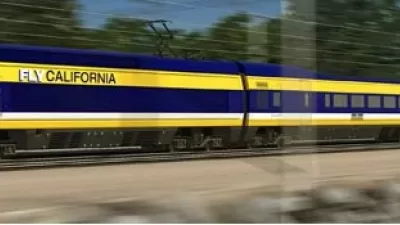While the revised business plan did shave off $30 billion, there remains a $55 billion funding shortfall. Dependent on federal and private funds that may never appear, could revenue from the sale of carbon credits bridge the funding gap?
The CA High Speed Rail project has received $3.3 billion in federal funds but remains dependent on an additional $35.3 billion, plus $13 billion in private investment, neither of which may be forthcoming soon, if at all. Gov. Jerry Brown has suggested that "cap & trade" funds, authorized by the landmark 2006 climate bill, AB 32, could provide revenue as early as November. Anywhere between $2 billion to $4 billion could come from the auction of carbon credits.
The Mercury News transportation reporter Mike Rosenberg, and environmental reporter Paul Rogers, write that the scheme "could either be a brilliant savior for the cash-strapped rail project or a disappointing enigma that disappears under legal scrutiny and opposition from businesses."
"It's the winning-the-lottery scenario," said Dorothy Rothrock, vice president of the California Manufacturers and Technology Association. "Counting on cap-and-trade revenues might not be the wise thing to do if it is so legally suspect that the money will never show up."
"At a news conference Monday in Fresno, rail leaders did little to play up the new funding possibility, nor did they return calls seeking more detail. But critics said it is likely to set off a massive legal showdown between business interests and the state."
Dan Richard, chairman of the California High-Speed Rail Authority, states in the Associated Press (via San Mateo Daily Journal, "(Cap & trade) gives us a backstop dedicated funding stream that gives us confidence that we can go forward".
The High Speed Rail board meets on April 15, Monday, to approve the revised business plan. Utilizing cap & trade funds is not on the agenda. Approval of the MOU for the blended rail agreements for northern and southern California are listed.
FULL STORY: Gov. Brown looks to global warming fees to pay for high-speed rail

Maui's Vacation Rental Debate Turns Ugly
Verbal attacks, misinformation campaigns and fistfights plague a high-stakes debate to convert thousands of vacation rentals into long-term housing.

Planetizen Federal Action Tracker
A weekly monitor of how Trump’s orders and actions are impacting planners and planning in America.

San Francisco Suspends Traffic Calming Amidst Record Deaths
Citing “a challenging fiscal landscape,” the city will cease the program on the heels of 42 traffic deaths, including 24 pedestrians.

Defunct Pittsburgh Power Plant to Become Residential Tower
A decommissioned steam heat plant will be redeveloped into almost 100 affordable housing units.

Trump Prompts Restructuring of Transportation Research Board in “Unprecedented Overreach”
The TRB has eliminated more than half of its committees including those focused on climate, equity, and cities.

Amtrak Rolls Out New Orleans to Alabama “Mardi Gras” Train
The new service will operate morning and evening departures between Mobile and New Orleans.
Urban Design for Planners 1: Software Tools
This six-course series explores essential urban design concepts using open source software and equips planners with the tools they need to participate fully in the urban design process.
Planning for Universal Design
Learn the tools for implementing Universal Design in planning regulations.
Heyer Gruel & Associates PA
JM Goldson LLC
Custer County Colorado
City of Camden Redevelopment Agency
City of Astoria
Transportation Research & Education Center (TREC) at Portland State University
Jefferson Parish Government
Camden Redevelopment Agency
City of Claremont



























